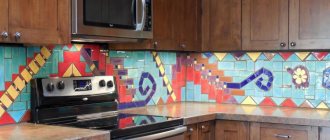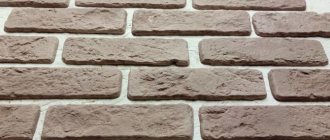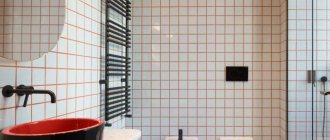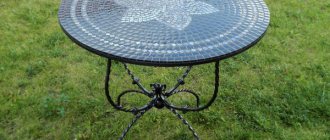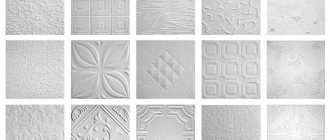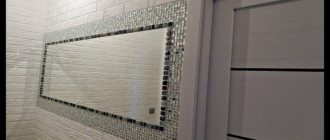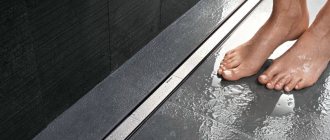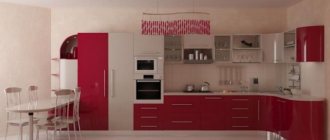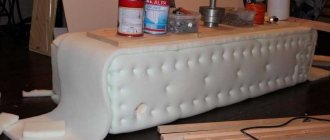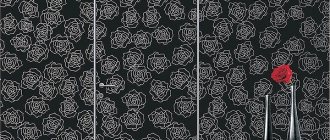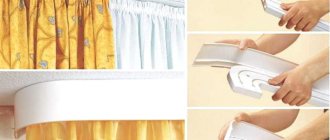Natural elements in an apartment, house or office are an effective design solution that will add a special touch to any room. Moreover, it is not necessary to create a single interior style; individual inserts and eclecticism are acceptable. For example, a wall made of “wild stone” looks interesting in a nautical-style room or a high-tech kitchen. But even for a classic living room there is a use for such an element. And, as for lofts, ethnic and Scandinavian interiors, tiles will become the main forming material in them. Today she is in trend. Laconic design and rough, but at the same time, elegant simplicity are becoming fashionable, and with the improvement of production technologies to imitate natural materials, decorative stone tiles look realistic.
The popularity of this design supports the fashionable trend of leading a healthy lifestyle and ecology.
Advantages
The widespread use of artificial tiles imitating a cobblestone wall is due to its advantages. Advantages of the material:
- installation of tiles of this type does not require special skills and can be done independently, provided that you have basic knowledge in repair and construction;
- this material weighs less than cement tiles, so it can even be attached to drywall;
- the product line includes budget options (the minimum cost depends on the region; in Moscow, for example, according to the price lists of individual companies, prices start at 450 rubles/sq.m.);
- the material has increased fire resistance and does not conduct electric current, so it can be used when renovating a kitchen or nursery;
- the tile has excellent heat-conducting and sound-insulating properties;
- natural elements decorate any interior;
- this material is environmentally friendly;
- There are many modifications of tiles; they can recreate any type of stone or brick.
Is it possible to do it yourself?
It is possible, but the performer will need to be attentive; the process is labor-intensive. In addition, special molds will be required to give the products the required volumetric texture. To obtain products with a smooth surface, it is possible to use improvised containers. Forms with natural stone relief can be made independently or purchased. In the second case, quite significant financial costs will be required. Therefore, doing it yourself is advisable from a financial point of view only in the case of large-scale work, complete finishing of a wall or several walls. The least cost of materials will be required to create gypsum tiles, so the following video shows the production.
Flaws
But when choosing a building material, you cannot focus only on the positive aspects. It is better to be aware of all its shortcomings in advance in order to minimize them when using it. You need to understand what you will have to sacrifice if you choose this particular tile and not something else. The main disadvantages of the material:
- gypsum products begin to quickly deform due to the high moisture absorption of the tiles, this can be avoided using various substances (you can use a special primer in advance, for example, Primer X94);
- decorative tiles break easily, do not have high strength and resistance to abrasive influences, so you should be careful when installing them;
- the material has poor frost resistance qualities;
- “wild stone”, due to its textured surface, collects dust and requires frequent cleaning, so after installation it is better to varnish it (the non-varnished surface is treated with a solution of 50 ml of fabric softener dissolved in 200 ml of water).
Kinds
There are several classifications of natural stone tiles. One of them divides the varieties of this material by application. Types of decorative tiles depending on the place of application:
- façade – used for external cladding of walls of buildings in the private and commercial sector. Its features include the absence of a mechanical connection (not counting grout) between adjacent elements, the need to seal seams and waterproof the entire canvas;
- floor – made of PVC or porcelain stoneware. Floor tiles are chemically neutral, do not wear off, do not deteriorate due to sudden temperature changes, and are also highly durable. The most durable floor covering is considered to be paving;
- wall-mounted – used for interior decoration. It weighs lightly, and therefore simplifies the installation process. Such tiles have a huge number of design varieties (for example, tiles in the bathroom);
- ceiling - has the least weight of all types of decorative tiles. Its thickness should be no more than 1 centimeter in order to cover the entire ceiling of the room.
Plaster
The tiles are produced in two modifications: gypsum and ceramics. Gypsum tiles usually imitate natural stone or a brick wall. It is durable and allows you to forget about redecorating the premises for many years to come. There are painted and unpainted, smooth or embossed varieties of material. It is used when decorating closed loggias and balconies, walls and ceilings in rooms and corridors. Gypsum tiles are used to decorate home fireplaces, but for fire safety it is better to equip them with heat-insulating panels. The natural composition of gypsum allows you to maintain a favorable microclimate. But still, this material is not used in the decoration of baths and saunas due to its high moisture absorption. For the same reasons, after installation in any room, the tiles are treated with a water-repellent agent.
No substances will help the “wild stone” made of gypsum cope with climatic factors, so it is not used in the external cladding of houses.
Ceramic
Ceramic tiles have increased durability and strength. It is able to withstand a variety of mechanical loads without damaging its entire structure. The material is used in facade decoration because it is not susceptible to environmental climatic influences (although, of course, when choosing a product and brand, one must focus on regional characteristics). But ceramic tiles play the main role in the interior of the living room, dining room, kitchen, hallway and bathroom. If you want the room to look “richer,” you can make inserts from tiles that imitate marble or onyx. Moreover, in accordance with international standards, this material is practically no different from natural analogues in its technical properties and appearance. A wide range of ceramic stone tiles allows you to choose the best material option for absolutely any architectural solution. Moreover, it does not absorb dirt and odors, and therefore is convenient to use.
Advantages and disadvantages
Exterior stone has both advantages and disadvantages. The advantages of this material include:
- quick installation without prior professional training;
- light weight compared to cement tiles;
- Possibility of mounting on drywall;
- wide price range of product options;
- high degree of fire resistance;
- safety for human health;
- thermal conductivity;
- soundproofing;
- many variations of textures.
However, there are some nuances that can be considered as disadvantages of the finishing material. Compared to natural materials, tiles are less durable and resistant to physical abrasion. Some samples do not tolerate direct sunlight, chemical treatment and sudden temperature changes.
Colors
The color schemes of the tiles are varied and completely imitate the elements of nature. Moreover, the double technology of coloring the relief base leads to the fact that there are no two identical tiles. The color of the veins and protuberances will always vary. The choice of shade depends on the style and personal preferences of the designer, but still, when using this material, you should rely on the natural palette. It is customary to classify decorative tiles by color depending on the type of stone that is imitated. The following types are distinguished:
- marble imitation involves the use of white, black and beige with a slight splash of gray;
- malachite tiles should be dark green with some streaks;
- onyx will be presented in pink, amber and light green colors;
- gray and beige shades are suitable for decorative sandstone;
- artificial slate has a brown, gray-green tint with light veins;
- a mixture of stones involves the use of natural shades (brown, white, reddish, etc.).
Simplified options for facade decoration
“Lighting will create the right mood and emphasize the beauty of the decoration of the facade of the house”
If you are not ready to cover your house with siding, wood, etc. In ways to make his image complete, you can use one or more of the following design moves:
- Bright, beautiful cornices will help you quickly and easily transform the appearance of a building.
- Window frames painted in unusual colors will significantly change the exterior of a country estate. An excellent solution would be to add shutters to them
- Window and door openings, as well as house corners, can be decorated with façade elements such as towers or columns.
in modern facade finishing materials such as painted aluminum are used
In the dark, skillfully organized lighting can become a façade decor. To do this, you need to use wall and hanging lanterns of various designs, LED strips. Lighting will create the right mood and emphasize the beauty of the decoration of the facade of the house. In addition, light will make the area more comfortable and safe. Agree, it is much more pleasant to climb the well-lit steps of the porch or drive into a garage door flooded with light than to stagnate there in complete darkness.
façade cladding with bassoon under brickwork
There is another non-standard option to give the house an unusual look - to hide its walls behind a living facade. The shoots of climbing plants are distributed over a metal mesh specially arranged along the walls. Such a living finish will require careful maintenance. The shoots will need to be trimmed in a timely manner so that they do not entwine the windows, and the plants themselves will need to be watered and protected from pests. This is not particularly problematic in our time, so it’s worth taking note of the idea.
Conclusion
Finishing the facade of a house, no matter how it is done, is additional protection, insulation and decoration for it. As can be seen from the above, the decorating process is not always expensive. You can do a lot yourself by looking at projects on the Internet.
Living in a beautiful, practical house that attracts attention with its unusual exterior is incredibly pleasant, and you should not deny yourself this pleasure!
Application
There are a huge number of options for using decorative brick tiles. Conventionally, they can be divided into standard and non-standard. Standard methods include:
- decorating a separate corner of the kitchen (for example, next to a gas stove);
- cladding of internal and external walls;
- creating a special “Christmas” coziness by edging the fireplace;
- bathroom decoration;
- use for window and door openings;
- mirror edging, etc.
Non-standard (conditionally) methods of using artificial stone are:
- tiling the working surface of the kitchen set, which smoothly transitions into the apron (without dirt accumulating under the lower edge of the apron tile);
- decor of old furniture;
- from broken tiles (the material is fragile, something will definitely break during installation) you can make a small panel on the wall;
- decoration of garden benches, flower beds and pots;
- You can make a custom canvas for adults and children from white wall tiles (you need to paint on it using special paints for glass or ceramics);
- decorating the stairs in the cottage;
- Extra tiles can be used as a stand for hot or cold dishes.
Decorative stone in various styles
Natural materials such as stone and wood are not so easy to integrate into a versatile style. Artificial tiles allow you to choose an imitation of a natural product. Moreover, the price of the material is quite reasonable; for example, natural marble is much more expensive than ceramics.
Classic style
This category includes the following styles:
- antique;
- baroque;
- neoclassicism;
- Renaissance.
All of them are united by the desire to create a luxurious, solemn, pathetic interior from:
- granite;
- marble;
- aventurine;
- interspersed with mica - companions for decorative surface cladding.
For the most part, decorative stone is chosen to decorate columns, fireplaces, and walls. The key is to maintain thoughtful relationships between all design details. Artificial slabs are also used as flooring. Bathrooms are decorated with smooth marble-like stone.
How to choose?
Artificial decorative stone for external and internal decoration is selected based on price, durability, reliability, ease of use and appearance. You should also pay close attention to the manufacturer of the product. If a company has long established itself in the market and has a large range of products, then its decorative tiles can be purchased. By law, tiles are not subject to mandatory certification, but the presence of such a document indicates that the company is attentive to its consumers and tests its products (if a large holding company buys a product from a small manufacturing company, it always requires technical documentation for testing). If the consultant refuses to provide quality certificates, you should think about the advisability of making a purchase.
When choosing a fake stone, you need to pay attention to its frost resistance indicators. The larger they are, the longer the material will last (this applies not only to the facade, but also to the internal cladding). Correct tiles have a textured surface that is indistinguishable from ordinary natural stone. When purchasing tiles, you need to look at their surface. If it is porous, then this indicates a violation of the production technology (for example, the casting mixture was moved). Such a stone will not last long; moisture will begin to enter the formed pores, which will lead to the destruction of the material. You should also pay attention to the thickness of the product. Depending on the purpose of the tile, it varies from 1 to 5 centimeters. Ideally, the thickness of the stone should be uniform along its entire length and width. In case of unevenness, such decorative tiles will be difficult to lay on a wall or floor; additional finishing work will be required to restore the defect (at least visually).
Interesting solutions
A coating with a torn stone design is fascinating because the pattern is almost impossible to trace; obvious irregularities in the structure create the impression of lost integrity.
The solution is very original and interesting; it is used for interiors in which the appearance of the walls needs to be emphasized.
Laying
The entire process of laying artificial stone is divided into the following stages:
- First, the old coating is dismantled. If you plan to decorate the entire wall or ceiling, then the covering is removed completely. Otherwise, only part is removed.
- Then the walls are leveled, since the stone must be laid on a smooth surface. Cracks are puttied, and large differences and slopes are sanded.
- After sanding comes the priming stage. Before this, the surface should be cleaned of dust and other dirt. Only after this the area is treated with a primer (preferably acrylic).
- The tiles have uneven edges, so they need to be assembled like a puzzle on the floor using a meter. Identical fragments should be in contact with larger and smaller ones.
- Then you should prepare the glue (it should be thick and uniform without lumps) and proceed with the installation itself, paying special attention to the corner joints.
- After laying the tiles, you should wait from 3 to 10 days, depending on the type of adhesive and the characteristics of the room. Only after this period will the tile adhesive finally dry, and the structure itself will become durable.
Creating a personal interior
One tile under a household stone can contain figures of different sizes and this makes it unique.
The coating looks heterogeneous, and the arrangement of the slabs and the pattern can be drawn up yourself or trusted to a master.
It is very easy to realize personal wishes or fantasies with this type of cladding.
How to care?
Caring for decorative tiles involves wiping off dust in a timely manner. To avoid problems with excess moisture, the cladding is treated with hydrophobic sprays. Thanks to this coating, the tiles can be easily washed in the future. But it is better to use a special cloth with microfiber rather than an ordinary one to process it. A spray bottle is also suitable for spraying flowers. Cleaning with a vacuum cleaner (preferably a washing one) will be effective. A static broom is recommended for some surfaces, but is only necessary for dry cleaning. A regular porous sponge is suitable for cleaning a kitchen apron. As detergents, it is better to choose special products for processing artificial stone. Sometimes they use fabric softener, but there is no need to overuse this method, since the surface of the tile may deteriorate. The frequency of cleaning decorative stone depends on the humidity of the room, as well as the presence of objects in the apartment (house, office) that collect dust.
Installation process
Doing the installation yourself is not too difficult. Carrying out the work yourself will also save money. To obtain a high-quality, durable and reliable coating, you must follow some recommendations:
- It is necessary to inspect the purchased tiles for chips and color uniformity.
- The base must be strong and prepared : dirt is removed, cracks and irregularities are removed, the surface is leveled with putty and primed.
- Laying is carried out in the direction from the corner.
- According to various experts, the adhesive solution can be applied only to the base, only to the facing material, or to both surfaces. Manufacturers provide installation recommendations, you need to follow them.
- The gaps are rubbed with a special product, to which it is recommended to add coloring pigments to match the coating.
The process of laying gypsum tiles is clearly presented in the following video.
